Development of Power Conditioners (V2H) for EVs
- Shigemasa Furuie
- Takeshi Suzuki
- Jun Kozuchi
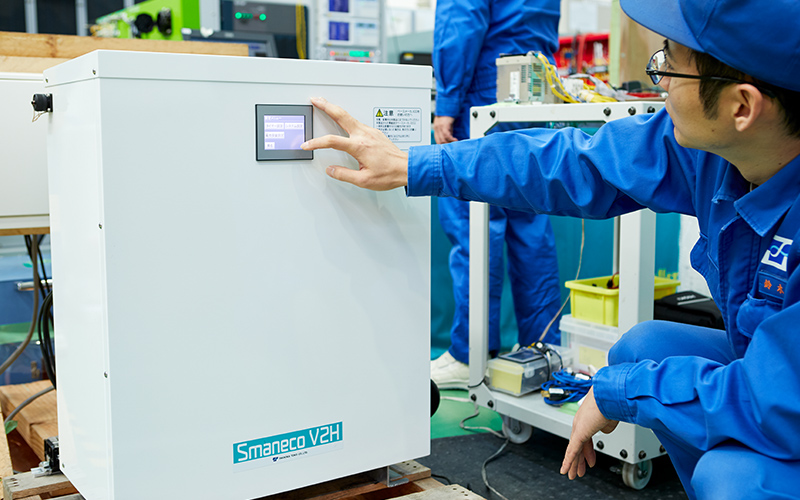
In 2012, the feed-in tariff (FIT) system was introduced as a measure to promote the introduction of renewable energy toward the realization of a clean environmental society that does not depend on petroleum resources. Along with this, the spread of solar power generation in general households has also expanded. However, since the purchase period of FIT for housing will begin to end from 2019, the use of solar power generation is expected to shift from selling electricity to self-consumption.
A typical example of a device that stores energy without wasting generated power is a stationary storage battery, but electric vehicles (EVs) and plug-in hybrid vehicles (PHVs) can also play this role. increase. EVs and PHVs are expected to be used effectively not only as automobiles but also as power sources for homes, and the need for them as emergency power sources is also increasing. In response to these trends, TAKAOKA TOKO has developed and commercialized a small V2H (Vehicle to Home) that can supply power to homes. We will therefore introduce this technology.
Technology
Smaneco V2H*1 has achieved a compact size with a capacity of 3 kW.
Smaneco V2H is designed to supply 3kW of electricity from an EV to a general house, making it a product that can be used with most home appliances. In addition, we have achieved a smaller size compared to conventional V2H, and V2H that is more suitable for home appliance use in ordinary homes has been born. Since this product uses a non-interconnected system*2, it is possible to supply power from the EV to home appliances even in the event of a power outage or disaster.
Since Smaneco V2H is compact, it is expected to be introduced to homes that want to use EVs and evacuation centers of local governments that want to secure emergency power sources in case of power outages. In the future, TAKAOKA TOKO will also proceed with the development of an interconnected V2H system that can support the new VPP*3 specifications.
*1) An image character (Smaneco) for power electronics products that combines Smart (Wise), Neo (New), and Ecology (Environmental-friendly) is a registered trademark of TAKAOKA TOKO.
*2) A method that operates independently without being connected to the distribution system of an electric power company.
*3) Abbreviation for Virtual Power Plant. This is a virtual power plant that aims to increase the introduction of renewable energy, such as solar power generation and wind power generation, and to reduce system stabilization costs through standardization of energy conservation and power loads. In this virtual power plant, energy resources distributed in regions are converted into remote control (IoT) and a resource aggregator is integrated and controlled to function like a single power generation facility.

Profile
-
 Shigemasa FuruieEnergy Solution Business Division
Shigemasa FuruieEnergy Solution Business Division
Energy Solution Manufacturing Department
Design group(at the time of development) -
 Takeshi SuzukiResearch and Development Center, Technology Development Division
Takeshi SuzukiResearch and Development Center, Technology Development Division
In charge of PCS, Future Grid Technology Group(at the time of development) -
 Jun KozuchiResearch and Development Center, Technology Development Division
Jun KozuchiResearch and Development Center, Technology Development Division
In charge of PCS, Future Grid Technology Group(at the time of development)
Small EV power conditioners for general households, born from the technologies cultivated in quick chargers.
Furuie:Originally, TAKAOKA TOKO develops, sells, and installs rapid chargers for EVs as part of its energy solution business. The background behind it is the fact that sales grew in 2013 to 2014 with a subsidy system. Next, when we thought about what to do with charging infrastructure and EV-related businesses, we focused on this EV power conditioner business called V2H.
Suzuki:When participating in an EV quick charger competition for a major domestic automobile manufacturer or from communications with a charger construction company, we were able to understand the needs of the world for V2H. This is also a factor that I decided to develop this product.
Kozuchi:At the time, the V2H that had already been commercialized had a capacity of 6 kW, which was a little large for general household. For this reason, "miniaturization" was our concept from the beginning of development in order to make the product specifications more suitable for household use.
Furuie:Since the power electronics technology cultivated in quick charger can be applied to V2H in many respects, and we also had knowledge about EVs themselves, we thought the power supply could be reduced without hindrance in view of the average amount of power consumed in a household, if the capacity is 3kW. Therefore, we began to develop the technology from the determination of the product specifications themselves.
Kozuchi:Generally, solar power generation equipment adopts an interconnection method that generates power by connecting the equipment to the distribution system from the electric power company, In this project, we adopted a non-interconnected system to enable power to be supplied to houses without being affected by the power system. Therefore, in the development process, we spent a certain amount of time to consider how far we could add functions while keeping the concept of downsizing.
Suzuki:Aiming to make the product smaller than those on the market, while retaining the advantages and reducing the disadvantages as much as possible. The existing technologies of TAKAOKA TOKO were applied when they were available, and if the technology was quite new and needed to be developed, we proceeded with the development while borrowing the knowledge of expert.
Furuie:The V2H is equipped with a power supply function not found in quick chargers, so bidirectional power conversion is required. Smaneco V2H is a DC charging of EVs with electricity distributed by power companies. They can also be switched manually, and are designed so that charging and power supply can be set in units of one hour by the schedule operation function.


Disasters, environmental issues, and renewable energy. Future of electricity supported by EV and V2H.
Suzuki:This Smaneco V2H is targeted mainly by households that have solar power generation equipment at home. However, there are two main driving patterns. These patterns vary depending on whether or not they are used in conjunction with solar power generation.
Kozuchi:When used together with solar power generation, the EV is charged during the day when power is generated, and after the sun goes down in the evening, the EV will supply power to the household. On the other hand, if they are not used together, the EV will be charged with cheap late-night power at night, and the EV will supply power during the day when the electricity rate is high. The mechanism can thus perform switching between charging and power supply. This switch makes it possible to use electricity more efficiently and at lower cost during the day.
Furuie:In response to the fact that the electric power purchase period under the FIT will begin to end in 2019, self-consumption of electricity is necessary. Instead of immediately consuming the generated electric power on the spot, the automobile itself is regarded as a storage battery. The biggest advantage of this device is that it can be used effectively by charging it in advance.
Suzuki:Smaceco V2H is also expected to be introduced to local governments as an emergency power supply in the event of a disaster. Of course, EVs have their original role as automobiles, so if you think of them as storage batteries, they are extremely low-cost. In some cases it can be regarded as a "mobile storage battery," so I think that the possibilities will expand gradually depending on how it is used.
Kozuchi:Of course, it is possible to apply the technology used for EVs to PHVs in the same way, depending on the standards. As the number of introductions to general households increases and knowledge increases, the realization of technology to supply power to larger public facilities will become apparent.
Furuie:We are planning to develop the interconnection type in the future based on the development of V2H of this non-interconnection type. By connecting to the power distribution system of the electric power company, it will eventually be possible to comply with the VPP specifications. For example, it may be possible to consider the power stored in a single EV as a "virtual power plant" for the entire community. In any case, technological advances in renewable energy are closely related to environmental issues. V2H is now just one point, but if they are connected, it will make a big contribution to society.

Latest articles
-
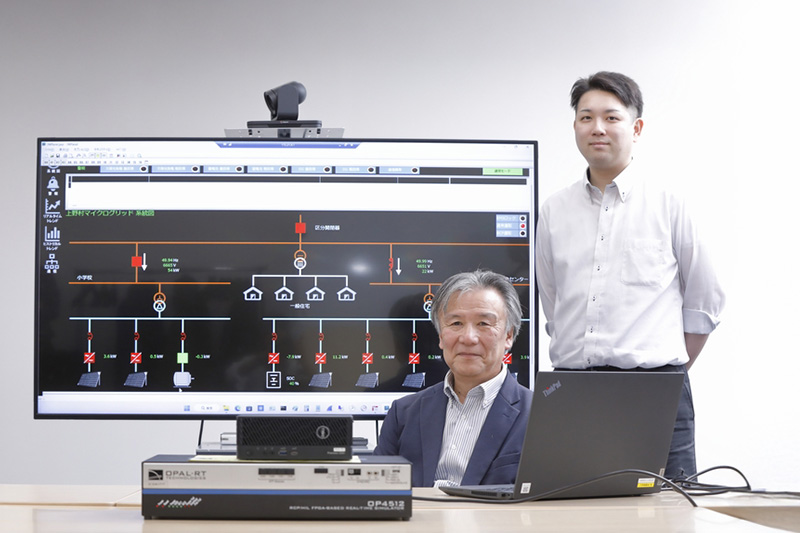 interviewBuilding a microgrid in Ueno Village, Gunma Prefecture, to Achieve Decarbonization and “Zero” Power Outages During a Disaster.The Sixth Strategic Energy Plan, a national policy, states that renewable energy is a main power source, and there is a need to expand the introduction of local power sources, including renewable energy. In recent years, the number of natural disasters in Japan has been on the increase, and a business continuity plan (BCP) is being emphasized for setting forth the methods and measures in advance to minimize the impact of an emergency and to ensure business continuity and a rapid recovery.
interviewBuilding a microgrid in Ueno Village, Gunma Prefecture, to Achieve Decarbonization and “Zero” Power Outages During a Disaster.The Sixth Strategic Energy Plan, a national policy, states that renewable energy is a main power source, and there is a need to expand the introduction of local power sources, including renewable energy. In recent years, the number of natural disasters in Japan has been on the increase, and a business continuity plan (BCP) is being emphasized for setting forth the methods and measures in advance to minimize the impact of an emergency and to ensure business continuity and a rapid recovery. -
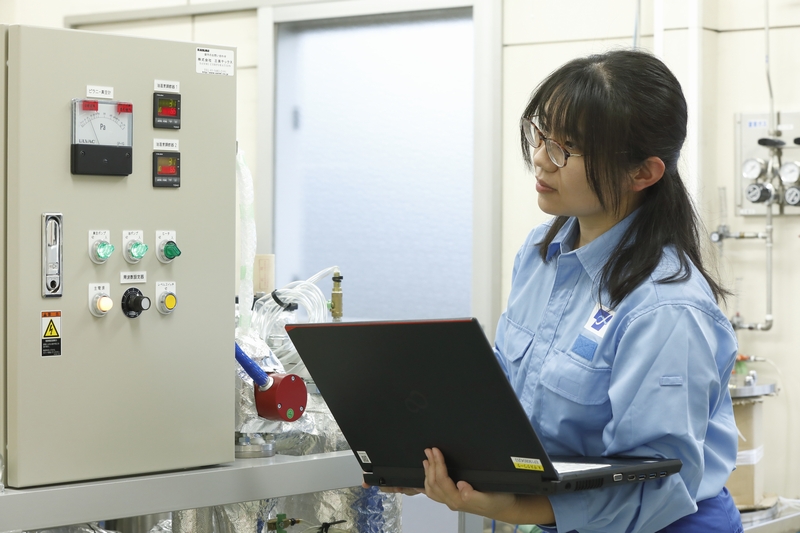 interviewRecycling technology of transformer oil aiming to achieve carbon neutralityNowadays, the work involved in carbon neutrality and the establishment of a recycling society is essential in business activities. The same trend is observed in the field of transformer oil. The international standard for the quality of transformer oil has been revised; there is now no distinction in quality between new transformer oil and recycled transformer oil (hereinafter “recycled oil”) abroad, which allows them to be treated equivalently.
interviewRecycling technology of transformer oil aiming to achieve carbon neutralityNowadays, the work involved in carbon neutrality and the establishment of a recycling society is essential in business activities. The same trend is observed in the field of transformer oil. The international standard for the quality of transformer oil has been revised; there is now no distinction in quality between new transformer oil and recycled transformer oil (hereinafter “recycled oil”) abroad, which allows them to be treated equivalently. -
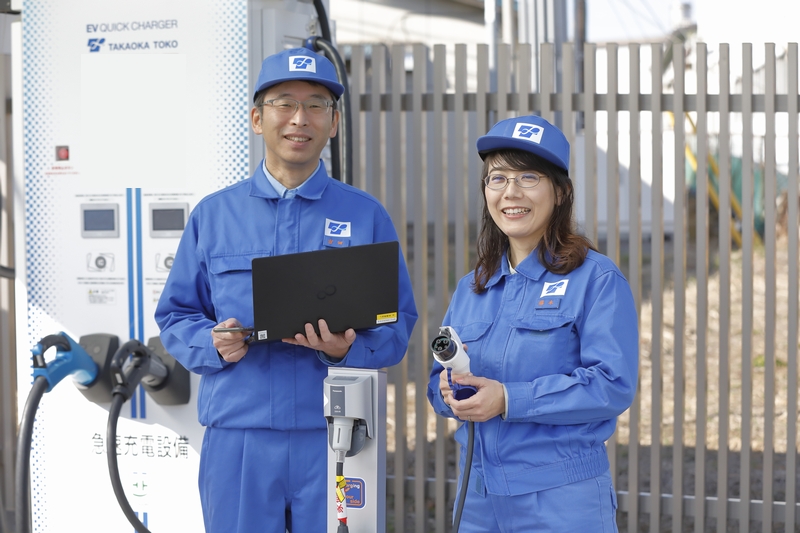 interviewWeCharge: EV charging management system that can be operated in large parking areasEfforts intended to achieve carbon-neutral levels have been made increasingly more often, which requires expansion of the EV charging infrastructure in order to propagate electric vehicles (hereinafter called “EV”).
interviewWeCharge: EV charging management system that can be operated in large parking areasEfforts intended to achieve carbon-neutral levels have been made increasingly more often, which requires expansion of the EV charging infrastructure in order to propagate electric vehicles (hereinafter called “EV”). -
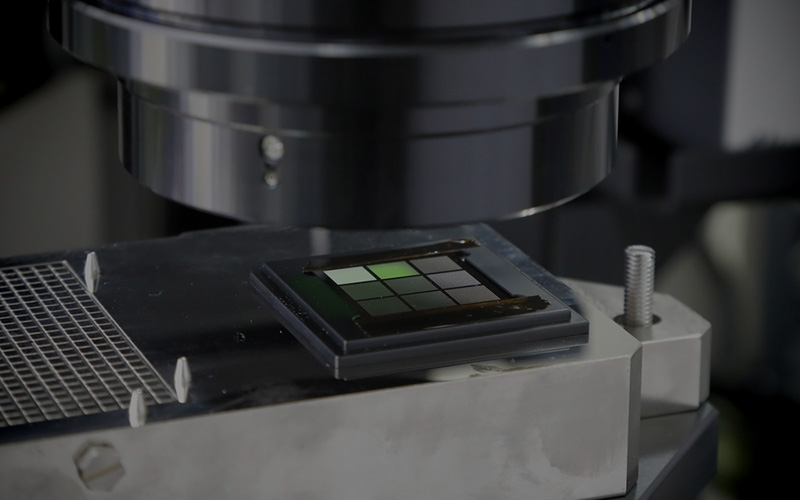 interviewThe confocal surface shape measurement system for semiconductor reliabilityIt is no exaggeration to say that semiconductors are used in everything supporting our lives and industry in modern society. Examples include smartphones, home appliances, and industrial products in various fields.
interviewThe confocal surface shape measurement system for semiconductor reliabilityIt is no exaggeration to say that semiconductors are used in everything supporting our lives and industry in modern society. Examples include smartphones, home appliances, and industrial products in various fields.
